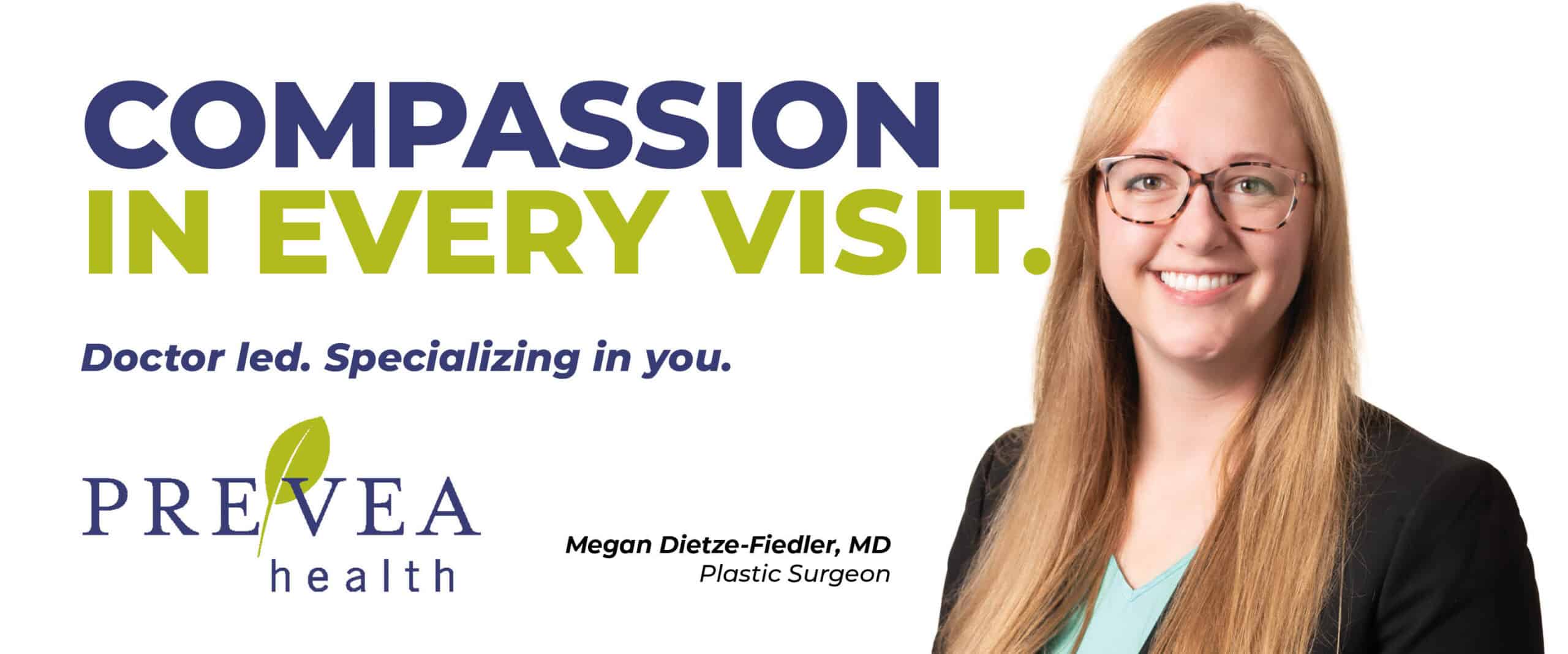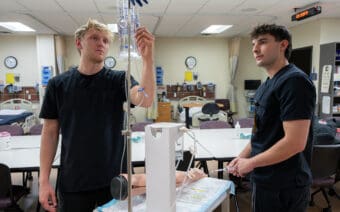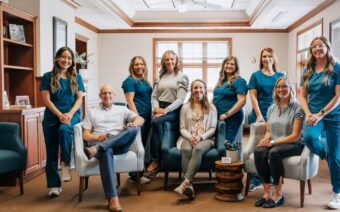
June 14, 2023
GREEN BAY – The Medical College of Wisconsin-Green Bay (MCW-Green Bay) opened its doors in the summer of 2015 – fulfilling a nearly decade-long dream of bringing medical school education closer to central and northern parts of rural Wisconsin.
Matthew Jenson was among the 15 medical students in the inaugural graduating class in 2018.
After a three-year residency for family medicine in Milwaukee, he returned home to Green Bay to become a partner with his father, Mark Jenson, in family practice at the Dousman Clinic.
Having an opportunity to attend medical school in his hometown, Matthew Jenson said, was a dream come true.
So, too, was the opening of MCW-Green Bay.
Making its mark
The MCW Board of Trustees approved the creation of MCW-Green Bay in June 2012 – making it the first medical school built in Wisconsin in more than 100 years.
Located on the St. Norbert College campus in De Pere, MCW-Green Bay was the first medical school in the nation to offer a whole campus three-year program through its 134-week “discovery” curriculum.
John R. Raymond, Sr., Medical College of Wisconsin (MCW) president and CEO, said though some U.S. medical schools had offered three-year programs before MCW-Green Bay 2015’s launch, they were always offered in addition to a traditional four-year medical school.
MCW, which is headquartered in Milwaukee, is home to the four-year curriculum.
//17bec5072710cda5b8dd81b69f4c6e58.cdn.bubble.io/f1686770784741x456367606988870000/richtext_content.webpJohn R. Raymond, Sr.
MCW is one of the largest private medical schools in the country, but Raymond said to simply increase the number of students at the Milwaukee campus, “we didn’t think we would have a meaningful impact.”
Matthew Hunsaker, dean of MCW-Green Bay, said with the three-year program, “what we were looking for is how to make medical college cost-effective.”
“While maintaining the quality of our graduates, lowering student debt and allowing them to enter their career a whole year earlier,” he said.
With preference given to Wisconsin students, Raymond said the goal of the two MCW regional colleges (MCW-Green Bay and MCW-Central Wisconsin, which was established in Wausau in 2016) is that the new generation of physicians will want to practice in northern and central parts of the state where primary care/family physicians, internists, pediatricians, obstetricians and psychiatrists are needed.
“Having these two regional campuses helped us grow into our name of the Medical College of Wisconsin,” he said.
Raymond said the goal was to think differently about how “we can address this maldistribution” of care problem and to look at the “outstanding health systems and doctors” in the northern and central parts of the state who could partner with MCW to train students and then build residency programs for graduates in order to retain them in rural Wisconsin.
“It’s too early to know for sure, but I would say it looks like it’s working,” he said.
Homegrown doctors
Raymond said statistics show that if someone goes to medical school and then does their residency in the same region, there is a 75% likelihood they will practice medicine in that area.
MCW-Green Bay has now graduated its sixth class of medical students – 22 new physicians came out of the class of 2023 – meaning MCW-Green Bay has now, according to Hunsaker, educated 140 physicians.
Some of those first graduates recently completed or are just starting to complete their three- to five-year residency programs, he said.
//17bec5072710cda5b8dd81b69f4c6e58.cdn.bubble.io/f1686770818145x127484907966444400/richtext_content.webpMatthew Jenson
The question is, are these MCW-Green Bay trained physicians returning to this region of Wisconsin to practice?
Hunsaker said they won’t be able to quantify the impact of MCW-Green Bay until about 10 years after its opening.
Jenson said he estimates 75% of the class of 2018 will be returning to the area.
He said he was at a classmate’s wedding recently that served as a “mini-reunion” and “out of the 10 of us, there were only two of us that were out of state.”
He said Green Bay is the right community for training those who want to work in rural Wisconsin.
“It worked very well (providing) a different feel obviously than the big city of Milwaukee,” he said. “It’s interesting, as you rotate through different specialties up here, you’ll have patients who come from all over… You’ll see a wide variety of Midwestern people coming to Green Bay. Green Bay is actually the gateway to the north (and) the Upper Peninsula. You get a feel for rural medicine and academic medicine.”
Tim Size, executive director of the Wisconsin Rural Health Cooperative based in Sauk City, said the MCW campuses in Green Bay and Wausau, along with the Wisconsin Academy for Rural Medicine (WARM), the rural medical education program at the University of Wisconsin School of Medicine and Public Health, are making a difference in Wisconsin.
This focus on rural medicine in the state couldn’t have come at a better time, he said.
Baby boomers – those born between 1946 and 1964 – are now retiring from careers in medical professions across the board, Size said, with the COVID-19 pandemic exacerbating some of those decisions to retire.
“Our state is facing a real crisis, and I think we’re already in the early days of it,” he said. “(In addition), I don’t think our state is prepared (for the aging population in Wisconsin). We are talking about a big chunk of the Wisconsin population where they require more care.”
According to the 2023 Health Care Workforce Report, as Wisconsin’s aging population continued to depart the workforce, high job vacancy rates persisted as demand for care grew in 2022, putting further strain on the healthcare workforce to grow at a fast rate.
“Wisconsin hospitals are working hard to grow, recruit, retain and support the healthcare workforce necessary to sustain the high-quality healthcare Wisconsin citizens expect and deserve,” Ann Zenk, WHA senior vice president of workforce and clinical, said. “But even with concerted effort, it is unlikely the healthcare workforce can grow fast enough to meet the rising healthcare demand of an aging population.”
//17bec5072710cda5b8dd81b69f4c6e58.cdn.bubble.io/f1686770850472x232165743136595330/richtext_content.webpTim Size
Size said that’s why MCW-Green Bay’s work is so important.
“By educating and training people in northern Wisconsin, who are being recruited by and large in northern Wisconsin, you’re seeing the new physicians staying in rural Wisconsin,” he said.
Future growth areas
Now, Size said, the goal is to grow residency programs, perhaps doubling the number, in northern and central Wisconsin.
“There are historical reasons why there are barriers to residency in rural areas,” he said.
This is, Size said, in part, because federal dollars that support the programs are disbursed more in the northeast part of the United States.
In addition, the “residency cap” is a federal law limiting the number of residency positions that can be funded by the Centers for Medicare and Medicaid Services, which Hunsaker said currently means “you have a finite number of residency spots in Wisconsin.”
In a report to the Wisconsin Department of Administration earlier this year, MCW noted two Northeast Wisconsin family medicine residency programs among its statewide offerings.
Mosaic Family Health Fox Valley Family Medicine Residency Program in Appleton is an affiliate program within the college with 21 residents.
The state provides funding for three resident slots in this program.
All of the six residents who graduated in 2022 remained in the state.
Prevea Medical College of Wisconsin–Green Bay Family Medicine Residency Program recruited its second class of first-year residents for the academic year 2022-23.
The “target” per MCW-Green Bay class, Hunsaker said, is about 80% of the students are either Wisconsin residents or have a connection to Wisconsin.
//17bec5072710cda5b8dd81b69f4c6e58.cdn.bubble.io/f1686770879187x314093372495902700/richtext_content.webpMatthew Hunsaker
“Because we are a workforce program with a specific intention – (to retain physicians in Wisconsin),” he said.
Community partners
Hunsaker said MCW-Green Bay is thankful for its community partners in large health systems to small private practice clinics – located in Green Bay and the Fox Valley, and as far away as Marinette and Fond du Lac – who are helping to train this next generation of physicians in rural medicine.
“We now have family doctors, obstetricians (and other specialty physicians) who are teaching students,” he said. “We want (students) to see the variety.”
The decision to place the MCW regional medical school in Green Bay, Hunsaker said, was “strategic and thoughtful” and was based on the willingness of healthcare systems and healthcare leaders to support the college.
“(I have a) feeling of gratitude to all of our partners, (for) without those local partners, this innovative model wouldn’t work,” Raymond said. “(Northeast Wisconsin) loves having their medical school there. They treat the medical students like they are essential… They make them feel very welcome.”
 A shining ‘Star’ of restoration and community philanthropy
A shining ‘Star’ of restoration and community philanthropy Ferguson’s Family of Farms celebrates decades-long legacy in western Wisconsin
Ferguson’s Family of Farms celebrates decades-long legacy in western Wisconsin







